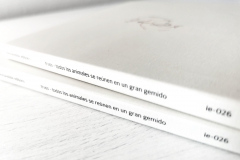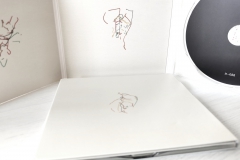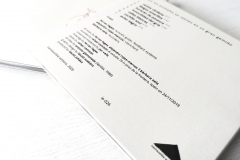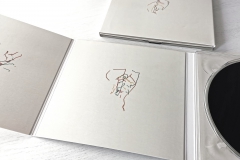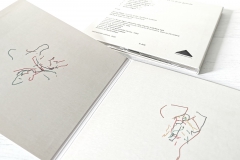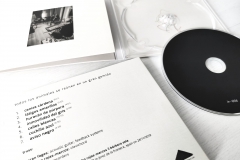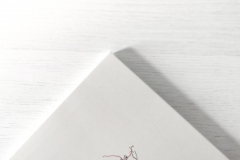TRUSS – Todos los animales se reúnen en un gran gemido
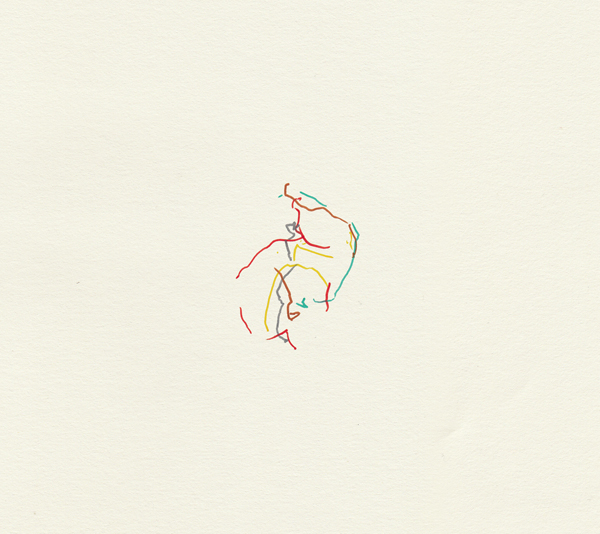
1. Ceniza Cárdena (8:21)
2. Látigos Amarillos (5:42)
3. Huracán De Púrpura (4:01)
4. Inmovilidad Del Gris (2:09)
5. Calles Blancas (10:10)
6. Cuchillo Azul (6:56)
7. Aviso Negro (4:29)
· Ferran Fages: acoustic guitar, feedback systems
· Alejandro Rojas-Marcos: clavichord
· Bárbara Sela: recorders
All music by Ferran Fages, Alejandro Rojas-Marcos & Bárbara Sela
Recorded by Rafael Camisón at Estudio 79 in Jerez de la Frontera, Spain on 24/11/2019
Mixed and mastered by Jan Valls
Drawing by Ferran Fages
Photo by Rafael Camisón
All titles by Antonio Gamoneda (Lápidas, 1986)
Graphic design by László Szakács
Produced by László Juhász
Released: August 2020 / first edition of 300 cds
Direct purchase: Bandcamp / Discogs
GALLERY ↓
REVIEWS ↓
“If you listen to underground music you are still a few meters closer to the surface than here. The difference is by no means subtle: this here is, in fact, the music of the underground, the chaotic agitation of creatures relentlessly struggling for their survival among the roughness of bare earth. Spanish trio TRUSS ventures through these dark and narrow tunnels with an instrumentation, to say the least, improbable: acoustic guitar (Ferran Fages), clavichord (Alejandro Rojas-Marcos) and recorders (Bárbara Sela) are being used, moreover, in such a way as to reveal phonemes in their rawest form, disorderly and emptied of meaning, thus accessing a para-expressive domain that replaces consciousness with instinct, tonality with the most elementary sound gestures.
Although the title of each track evokes a colour image, Todos los animales se reúnen en un gran gemido originates above all from the collision of nervous and inscrutable auditory dynamics that disregard any harmonic canon, and from which one’s imagination can therefore take refuge in complete abstraction. There remains, however, the persistent echo of a hybrid and ancestral ‘sound ecology’, with more or less direct references to the entomological and ornithological spheres: the dissonant calls and the strident diplophony of the winds, the metallic scraping of the bow on the strings, an indistinct variety of microscopic percussive interventions, are the elements that mingle and alternate in the free hatching of a faunal scenery in continuous metamorphosis.
Before the ‘fine arts’, the epics and the suave poems of ancient times, a mythological bruitisme similar to that of TRUSS had probably manifested itself, attuned to the labored breathing of primordial beings, still completely foreign to any Edenic or Romantic view of the natural world.” / Michele Palozzo, Esoteros, 6 September 2020
“There is a new release by TRUSS (Ferran Fages – acoustic guitar, feedback systems; Alejandro Rojas-Marcos – clavichord; Bárbara Sela – recorders) called, Todos los animales se reúnen en un gran gemido. It is harsh, irritating, screechy, grating and abrasive. In other words, it is very good, tough, no-holds-barred improv. Check it out.” / Brian Olewnick, Facebook, 10 September 2020
“Chwila oddechu na pewno była konieczna, albowiem teraz zapraszamy na obcowanie z całą plejadą fake sounds (fałszywych dźwięków). Przed nami trio: Ferran Fages – gitara akustyczna & feedback systems, Alejandro Rojas-Marcos – clavichord oraz Bárbara Sela – recorders. Na płycie, która składa się z siedmiu części i trwa prawie 43 minuty, niemal od początku do końca doświadczać będziemy dysonansu poznawczego, gdyż w wielu momentach, chwilami naprawdę ekscytującej improwizacji, całkowicie zatracimy umiejętność wskazania źródła danego dźwięku. Ta prawdziwa karuzela fake sounds nagrana została w Andaluzji (Estudio 79, Jerez de la Frontera), w listopadzie ubiegłego roku.
Opowieść o tym, jak wszystkie zwierzęta jednoczą się we wspólnym zawodzeniu nie mogła mieć lepszego tytułu. Rwana, nerwowa, chwilami chaotyczna, a po 30 minucie wręcz dotkliwa akustycznie narracja (prawdziwy challange nawet dla obeznanych w świecie fake sounds!) kasą swą niewątpliwą, elektroakustyczną urodą od pierwszego dźwięku! Mechanika preparacji, szelest obiektów nieznanego pochodzenia, meta rytm instrumentu klawiszowego, który chwilami brzmi jak fortepian, innym razem jak … klawikord, dźwięki, które mogą być efektem live proccesing, ale nie muszą, wreszcie nieustający rezonans wszystkiego ze wszystkim. Uff, fabryka pracuje pełną mocą! A na koniec ktoś podśpiewuje, a może jedynie jęczy. Druga improwizacja na moment powraca do żywych, rozpoznawalnych dźwięków. Słyszymy odgłosy charakterystyczne dla gitary Ferran Fagesa (yes!), struny klawikordu, głuchy szum otwartej przestrzeni studia nagraniowego, dźwięki suchych dysz instrumentu dętego, coś, co brzmi jak flet, a także głos ludzki – wszystko skąpane w rezonansie i sprzężeniach zwrotnych. Z biegiem minut preparacje nasilają się – tarcia, trzaski, gwizdy i pęknięcia. Trzecia część wydaje się najgłośniejsza jak dotąd. Gitara pracuje, także ów nieistniejący flet daje znać o sobie. Drżą i szeleszczą struny klawikordu. Intensywna, efektowna narracja z dużą ilością akcentów para-perkusjonalnych. Szorstka mechanika pocierania, uderzania i szarpania.
Czwarta historia, to niemal miniatura. Minimalistyczne wprawki w temacie wybrzmiewania niemal pojedynczych dźwięków. Coś pomrukuje, ktoś liczy struny, które rezonują. Piątą część rozpoczyna rezonans gitary, mechaniczne mikro frazy, jakby ktoś umieścił wszystkie przedmioty wydające dźwięk w wielkim pudle rezonansowym fortepianu. Znów akcenty percussion i dźwięk charakterystyczny dla fletu prostego. Zagubione w głuszy leśnej dźwięki maltretowanej natury, tej ożywionej i tej wegetującej. Pod koniec słyszymy suche, drewniane patyki, którymi ktoś pociera, w tle zaś rezonują struny gitary (tego jesteśmy akurat pewni!). Opowieść toczy się jak u Davida Lyncha – nie ma rozwiązania, mnożą się natomiast zagadki – świst, szelest, pojękiwania, molekularne źdźbła fonii. Piski, uderzenia, oddech instrumentu dętego (?). Gdybyśmy powiedzieli o tej improwizacji, że sprawia wrażenie wyjątkowo tajemniczej, to jakby nic nie powiedzieli. Zakończenie szóstej improwizacji stawia na intensywność, chwilami naprawdę bolesną. Głębokie preparacje i rezonujący ambient gitary. Wreszcie finał tego szalonego przedsięwzięcia fonicznego – wszystko zdaje się tu wyć i piszczeć z egzystencjalnej trwogi. Z klawikordu buchają pioruny, ale całość narracji systematycznie przygasa. Wraz z artystami i ich meta instrumentami docieramy do ostatniego dźwięku. Jesteśmy dumni – z siebie, a tym bardziej z nich!” / Andrzej Nowak, Trybuna Muzyki Spontanicznej, 29 October 2020
“Thanks to my habit of neglecting to read the sleeve notes, I only just realised that all three albums here are from Inexhaustible Editions. Also thanks to this habit, I was completely unprepared for Nick Ashwood’s solo release Unfolding/Overlay. I glanced over it, saw ‘acoustic guitars’ and figured we’d get to hear a solo approach as heard on his group improvised efforts, so my first listening was spent mostly getting over the shock of how it sounded. A steely tambura drone opens the album-length piece, which I figured was going to be the groundwork for some trancey guitar noodling until it gradually dawned on me that this was the trancey guitar stuff. Ashwood’s made this piece from two long, unedited takes of bowing on an acoustic guitar and then superimposing them. As performance, it’s a meditative experience, at once introspective yet open-minded, with the slow but purposeful drifting that comes from bringing the mind to an alert passivity through concentrated action. As a composition, the listener hears the constant weaving of bowed chords as a single, braided strand, with illusory harmonies and timbres and breathing pulses that can become either strong or frail, simple or complex, always evolving into something new of its own accord.
Just a small spoiler: the first fifteen seconds of Ferran Fages’ From Grey To Blue are silent. You might want to keep that in mind before cranking the volume. Not that the piece is loud, but it is clearly present: a forty-minute work for a full and closely-miked piano, played by Lluïsa Espigolé. Thinking back to Fages’ Un lloc entre dos records, a work for solo guitar and sine tones, and remembered that it was difficult to get a grip on: “The mind struggles to reconcile the parts into a whole”. Fages pushes the unresolved shapes of his music even further here, perhaps past breaking point. The piece falls into three parts, but in each the phrases are brief and widely separated by silences. Fages and Espigolé have collaborated over a couple of years and her playing, although described in the notes as “without emotion”, captures something tentative, even reluctant to proceed. At least there’s no sentimentality, even though the gently paced combinations of single tones and minor chords (rarely more than dyads) could lend themselves to drama. In the central section, the sounds themselves seem to thin out; when more chords return in part three everything happens more slowly. It’s described as a study in resonances and the spaces between sounds, but I’m usually pretty skeptical of pieces which make a virtue of reticence. With each successive listening, however, the sounds start to feel more tied together and playing it loud reveals the piano mechanism at work and the voids start to fill in as though they’re making some sort of connection; but as to what those connections might be, I’m not sure.
Fages is also part of the group TRUSS, playing acoustic guitar and feedback with Alejandro Rojas-Marcos on clavichord and Bárbara Sela on recorders. Todos los animales se reúnen en un gran gemido is a set of seven tracks recorded on one day in late 2019. They are apparently group improvisations but I keep hearing Fages’ methods at work. There are sustained high, keening passages as heard in his earlier piece Radi d’Or and, as the album progresses, the sounds start to break up into irresolute fragments. It’s stupid to attribute this to one musician when there are three at work. It sounds like Rojas-Marcos is using various extended techniques on his instrument, complicating the picture of who plays what when paired with Fages’ guitar. Sela’s recorder can either lead or shadow the high-pitched bowing and feedback, or otherwise derail and obstruct the continuity, forcing new approaches. The way the tracks are sequenced, the early sections are distinct and sometimes busy in that conventional group improv way, but around halfway through things become more fraught, with the music never quite succumbing to silence but always on the verge of breaking up, all the same. It’s not a comfortable experience, but it asks more questions of the listener than I originally bargained for.” / Ben Harper, Boring Like A Drill., 21 January 2021
RADIO PLAYS ↓
· Godbeni Imperializem at Radio Študent, Ljubljana, 1 October 2020
· No Wave at Tilos Rádió, Budapest, 31 January 2021
· Música Dificíl at Radio Mirage, Barcelona, 16 March 2021
· Llums de Tunguska at Ateneu del Clot, Barcelona, 21 April 2021
· Música Dificíl at Radio Mirage, Barcelona, 27 April 2021
· Nová hudba at Rádio Devín, RTVS – Rozhlas a televízia Slovenska, Bratislava, 16 October 2022
· Nová hudba at Rádio Devín, RTVS – Rozhlas a televízia Slovenska, Bratislava, 8 January 2023

